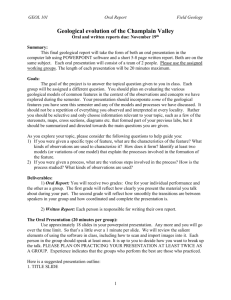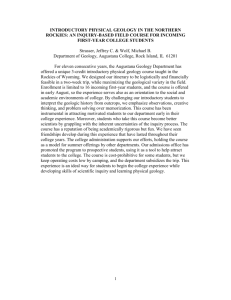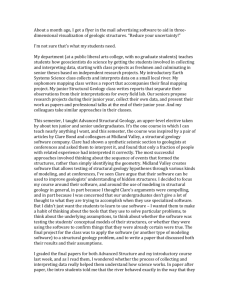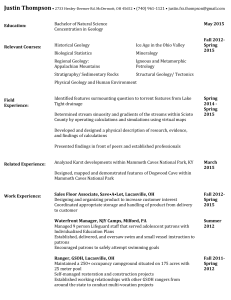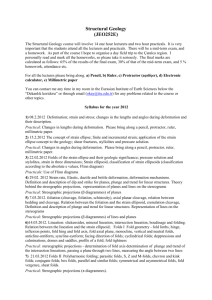stratigraphic folded
advertisement
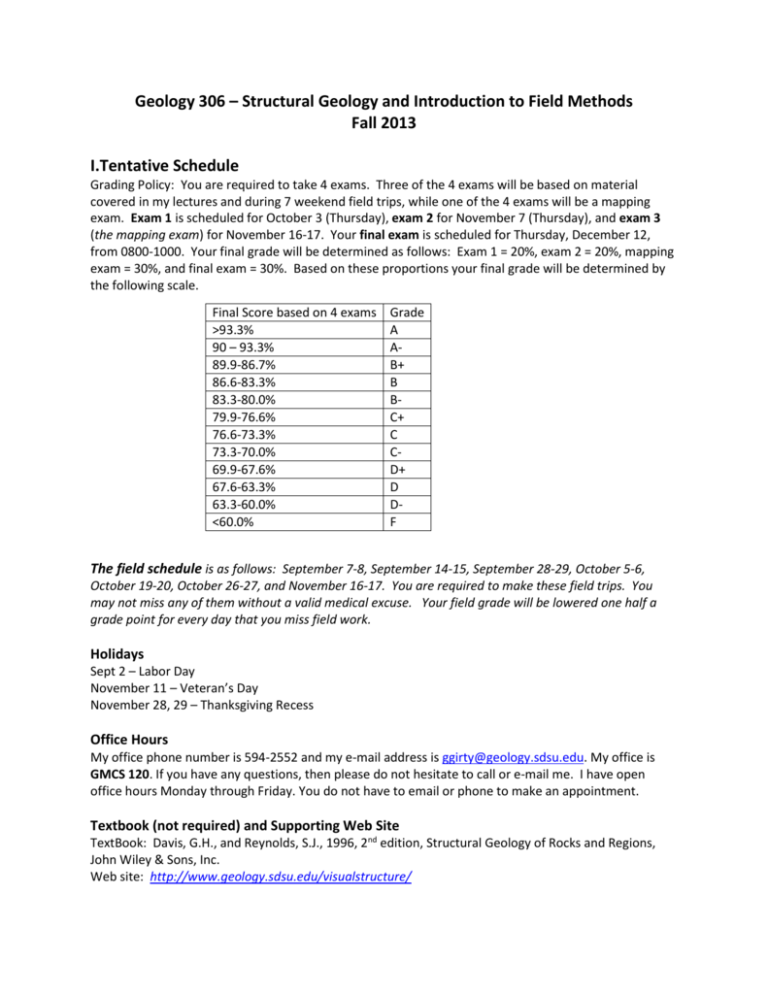
Geology 306 – Structural Geology and Introduction to Field Methods Fall 2013 I.Tentative Schedule Grading Policy: You are required to take 4 exams. Three of the 4 exams will be based on material covered in my lectures and during 7 weekend field trips, while one of the 4 exams will be a mapping exam. Exam 1 is scheduled for October 3 (Thursday), exam 2 for November 7 (Thursday), and exam 3 (the mapping exam) for November 16-17. Your final exam is scheduled for Thursday, December 12, from 0800-1000. Your final grade will be determined as follows: Exam 1 = 20%, exam 2 = 20%, mapping exam = 30%, and final exam = 30%. Based on these proportions your final grade will be determined by the following scale. Final Score based on 4 exams >93.3% 90 – 93.3% 89.9-86.7% 86.6-83.3% 83.3-80.0% 79.9-76.6% 76.6-73.3% 73.3-70.0% 69.9-67.6% 67.6-63.3% 63.3-60.0% <60.0% Grade A AB+ B BC+ C CD+ D DF The field schedule is as follows: September 7-8, September 14-15, September 28-29, October 5-6, October 19-20, October 26-27, and November 16-17. You are required to make these field trips. You may not miss any of them without a valid medical excuse. Your field grade will be lowered one half a grade point for every day that you miss field work. Holidays Sept 2 – Labor Day November 11 – Veteran’s Day November 28, 29 – Thanksgiving Recess Office Hours My office phone number is 594-2552 and my e-mail address is ggirty@geology.sdsu.edu. My office is GMCS 120. If you have any questions, then please do not hesitate to call or e-mail me. I have open office hours Monday through Friday. You do not have to email or phone to make an appointment. Textbook (not required) and Supporting Web Site TextBook: Davis, G.H., and Reynolds, S.J., 1996, 2nd edition, Structural Geology of Rocks and Regions, John Wiley & Sons, Inc. Web site: http://www.geology.sdsu.edu/visualstructure/ II.Tentative Lecture Schedule 1. Introduction – August 27 - September 1 a. Lithostratigraphic units – definition and hierarchy b. Time stratigraphic units (chronostratigraphic) – definition and hierarchy c. Geologic time units – definition and hierarchy d. Isotopic dating e. How the above are used to develop the geologic column and time scale 2. Primary Sedimentary and Igneous Features and Brunton Compass – September 2 - 7 a. Sedimentary structures – cross beds, cross laminations, graded beds b. Volcanic structures – pillow lava c. Strike and dip – definition and how to determine d. Quadrangle maps – scale, magnetic declination 3. Descriptive Structural Geology a. Joints and faults – chapters 5, 6 – September 9 - 22 b. Ductile shear zone – mylonites – chapter 9 – September 23 - 29 October 3– Exam 1 4. 5. 6. 7. Folds and the Lower Hemisphere Equal Area Net – chapter 7 – October 7 - 20 The Three-Point problem – October 21 - 27 Foliations and Lineations – chapter 9 – October 28 – 31 Construction of Cross-Sections – November 1 - 6 November 7– Exam 2 8. Theory and Mathematics a. Stress – chapter 2 – November 9 - 17 b. Strain – chapter 3, 4 – November 18 - 29 9. Whole Earth Structure and Plate Tectonics – chapter 10 – December 1 - 7 November 16-17 - Exam 3 – Field exam December 12 – Exam 4 (Final Exam) – 0800 – 1000 III.Objectives This course has several overarching and content goals. A. Overarching Goals/Outcomes After completion of this course students will be able to: 1. Articulate the multidisciplinary integrated nature of structural geology and mapping, and the importance of its role in their everyday lives 2. Articulate how technological advances along with the collection of a myriad of observational and analytical data over the last 200 years have lead naturally to the interpretation that the Earth's surface is broken into seven major plates, and that the interactions of these plates often directly or indirectly produces profound changes in Earth’s land surface and its interior, and claims the lives of hundreds to thousands of its inhabitants 3. Articulate how laboratory experimentation and observation has led to an enhanced understanding of dynamic earth processes such as faults, folds, and earthquakes, and, as a result, how structural geology and mapping may impact their quality of life 4. Articulate how the scientific method is used to infer the causes of naturally occurring events that alter the land surface and Earth’s interior. 5. Articulate examples of everyday observations that indicate that the Earth is dynamic and ever changing, and how these observations impact their daily life The above overarching goals are intertwined with the following specific content goals. B. Content Goals/Outcomes To meet content goals students will be able to: 1. Convey the idea that modern day plate tectonics and the structure of the Earth’s interior and land surface indicate that the Earth is in a constant state of change. 2. Articulate the role that convergent, transform, and divergent margins play in the development of fractures, faults, folds, and earthquakes. 3. Distinguish the mathematical differences between pure and simple shear, and be able to articulate the strain transformation equations. 4. Identify the different types of fractures and faults and demonstrate an understanding of their origin, distribution, and relationship to earthquakes and tectonic settings. 5. Convey an understanding of stress and rock strength, and how they interact resulting in the formation of variety of faults, fractures, and folds. 6. Distinguish the differences between the various types of folds and demonstrate an understanding of their origin, distribution, and relationship to potential hydrocarbon resources. 7. Articulate an understanding of how to produce a detailed map of a given structure or structures and its potential use in interpreting Earth history. 8. Convey that there are a conventional set of map symbols used to portray the geometry of common structures such as bedding, joints, faults, axial surfaces, hinge lines, and folds. 9. Articulate an understanding of the term deformation and how it represents a translation, rotation, dilation, and distortion (strain). 10. Convey an understanding of the Mohr equations for stress and how the Mohr-Coulomb failure criterion controls how a fault initially develops and then behaves after initial failure. 11. Articulate the uses of the stereonet for solving common 3D problems encountered in structural geology and mapping.

